|
|
 Red RF routes Red RF routes
Route 264
Page last updated 2 January
2016
One of the Kingston area routes, which worked mainly from
Norbiton garage until OMO conversion, whereupon it moved to
Fulwell.
An untidy-looking RF527
passes Kingston Station inbound to Kingston Bus Station, the blind
already having been changed for the next journey, a short-working
to Sunbury. The picture is clearly taken in the 1970s, when
RF527 was allocated to Kingston - it would have been
on loan to Fulwell. The
obviously-altered blind reflects the change in short-workings from
Sunbury Station to Sunbury Old Hanworth
Road.
Photo © AER
Brood, Peter Gomm collection
Dates of RF operation
10 Jun 59 to 17 Jul 76
Converted to OMO 23 Jan 66
(total 17 yrs 1 month, of which 5 yrs
7 months crew-operated)
Destinations
KINGSTON STATION and HERSHAM GREEN (Mon-Sat, 10
Jun 59 to 14 Jul 63)
KINGSTON Bus Station and HERSHAM
GREEN (Mon-Sat 15 Jul 63 to 17 Jul 76)
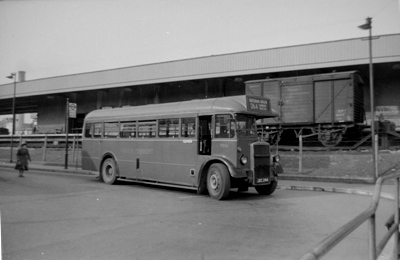 RF Garages RF Garages
NB Norbiton (10 Sep 59 to 22
Jan 66)
K Kingston
(9 May 62 to 7 May 63)
FW Fulwell
(23 Jan 66 to 17 Jul 76)
In about 1955, Norbiton's TD51 lays over at
Kingston Station.
Photo © Vic Youel
Reason for single-deck operation
The low bridge at Hersham Station always
required single-deck operation, but, in addition, the weight limit
on Walton Bridge also restricted the types of buses until
1953.
Route history
Walton Bridge over the River Thames had been
damaged in an air raid in 1940, resulting in the imposition of a
7-ton weight limit. At the time, the only route using the bridge
was the 218, resulting after the
war in the retention of the 1T1-types that were the only buses
which, fully laden, met the weight limit. Following the
complete rebuilding by Marshalls of Cambridge of 18 1T1s in 1949,
combined with the continuing allocation of unrestored buses to
Kingston, enough buses were available for a second route over the
bridge to be introduced as part of the post-war improvement
programme.
Introduced daily on 3 May 50, the 264
initially operated from Hersham via Walton and Upper Halliford to
Sunbury French Street and required four
buses. The route ran up Windmill Road to Staines
Road West, then straight along past Sunbury Clock Tower
(now the junction at the end of the M3 and renamed Sunbury Cross)
along Staines Road to terminate at the White Lodge Cafe.
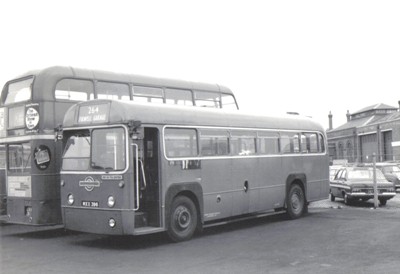 In October 1950, the route was diverted away from Upper
Halliford to run along the 237 road via
Sunbury Village and Green Street and the following year,
in June 1951, was extended along the 216
routing to Kingston (another two 1T1s being required). In
February 1957, the route was realigned again, away from Sunbury
Village and back through Upper Halliford. The Sunday service
was withdrawn in November 1958. In October 1950, the route was diverted away from Upper
Halliford to run along the 237 road via
Sunbury Village and Green Street and the following year,
in June 1951, was extended along the 216
routing to Kingston (another two 1T1s being required). In
February 1957, the route was realigned again, away from Sunbury
Village and back through Upper Halliford. The Sunday service
was withdrawn in November 1958.
RF419 was still hard at work
at Fulwell in July 1971, although by then only on the 206 and
264. It is seen in the yard next to RT1945, which would be
off to the scrapyard within a month.
Photo Peter Gomm
collection
Meanwhile, the route and seven 1T1s were
transferred to Norbiton when that garage opened on 14 May
1952. However, they were already end-of-life, despite the
rebuilds, and did not survive in sufficient numbers until the
replacement of the bridge at Walton in 1953. In the
intervening period, 14T12s and 10T10s were used with a limit on the
number of passengers carried across the bridge. These in
turn were replaced by TDs in 1954/5.
Before Kingston received its first RFs in July
1959, Norbiton lost its TDs in favour of the RF, indirectly using
buses made surplus after reductions following the 1958 strike and
also the conversion of West Green's 233
to double deck. A batch of buses (RFs 502-538) were converted
to OMO in the expectation of converting Kingston's single-deck
routes to OMO RF. However, union agreement was not reached
and after a short period, the RFs concerned were released to
convert the 264 and 206, together with
the 224 group, on 10 Jun 59, with the
216 (at K) and 250 (at NS) following on 1 July after crew
training.
As part of the allocation shuffle on Fulwell's first day of bus
operation, 9 May 1962, the 264 allocation was moved to Kingston,
except for part of the Saturday schedule which stayed at
Norbiton. This change reversed a year later when the route
returned to Norbiton, only to change again in 1966 when the whole
route moved to Fulwell on conversion to one-man operation on 23
January.
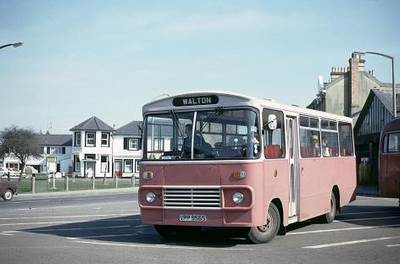 From here on, the route settled
down, with no changes for over 10 years until 1976. A major
reduction in the service in April was followed in July by
conversion to Bristol BLs, the first of the Kingston area
routes to lose its RFs. The BLs lasted for less than 18
months before the route was withdrawn on 28 January 1978, before
the Kingston RFs themselves finished. This resulted from a
withdrawal of support by Surrey CC, although a replacement service
between Walton and Hersham (the section not covered by other
services) was provided by Ben Stanley. That company ceased
trading in 1985 on the retirement of the proprietors; their route
passed briefly to Mole Valley Transport Services and is now covered
by Abellio route 564. From here on, the route settled
down, with no changes for over 10 years until 1976. A major
reduction in the service in April was followed in July by
conversion to Bristol BLs, the first of the Kingston area
routes to lose its RFs. The BLs lasted for less than 18
months before the route was withdrawn on 28 January 1978, before
the Kingston RFs themselves finished. This resulted from a
withdrawal of support by Surrey CC, although a replacement service
between Walton and Hersham (the section not covered by other
services) was provided by Ben Stanley. That company ceased
trading in 1985 on the retirement of the proprietors; their route
passed briefly to Mole Valley Transport Services and is now covered
by Abellio route 564.
It appears that Ben Stanley's rather
utilitarian, but at least bus-like, Marshall-bodied Bedford VAS5
replaced Plaxton coach-bodied YVQ LVS433P as a regular performer on
the Walton to Hersham route. Here is sits on the Hersham
Green stand with a short-working RF on the 219 just creeping into
the shot. The date is 24 March 1979, and the RFs have less
than a week left.
Photo © Dave Jones
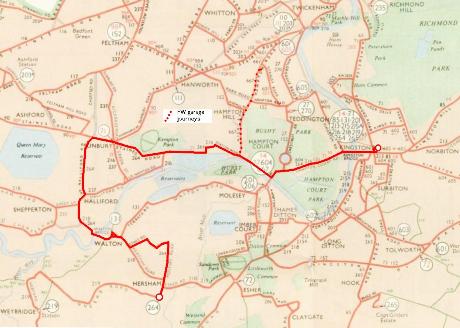 RF route
in detail, with timing points RF route
in detail, with timing pointsHERSHAM GREEN, Molesey Road, Hersham Barley Mow, Molesey Road,
Hersham Station, Molesey Road,
Rydens Road, Ambleside Avenue, St Johns Drive, Cromwell Road, Bowes
Road, Hersham Road, Walton High Street, Walton Bridge Street, Bear,
Bridge Street (15 May 65, rerouted towards Kingston via
Hepworth Way, Walton Hepworth
Way, Bridge Street), Walton Bridge, Walton Bridge Road,
Gaston Bridge Road, Green Lane
Gaston Bridge Road, Gaston Bridge Road, Upper
Halliford Road, Upper Halliford
Station, Windmill Road, Staines Road West, Sunbury Clock Tower (later
Sunbury Cross), Staines
Road East, Sunbury Harfield
Road, Upper Sunbury Road, Percy Road,
Hampton Station, Station Road,
Thames Street, Hampton Court Road, Hampton Court Vrow Walk, Hampton
Court Road, Kingston Bridge, Clarence Street, Wood Street, KINGSTON
STATION (exit via Clarence Street; 15 Jul 63, terminus changed to
KINGSTON Bus Station)
1961 bus map
© London Transport
Garage workings from FW: Wellington Road, High Street Hampton
Hill, High Street Hampton to line of route
Crew changeover and meal breaks were at Kingston Garage; from
1966, crews travelled from/to Fulwell via 281.
Frequency
| Year |
Mon-Fri |
Sat |
Sun |
| 1951 |
19-20 mins |
19-20 mins |
19-20 mins |
| 1953 |
30 mins * |
20-30 mins |
- |
| 1959 |
30 mins * |
20-30 mins |
- |
| 1964 |
30-40 mins † |
30 mins |
- |
| 1969 |
30 mins † |
24 mins |
- |
| 1971 |
30 mins |
30 mins |
- |
| 1976 |
30 mins |
25 mins |
- |
* more frequent Hersham - Walton Manor Road
(peaks)
† more frequent Hersham - Walton Bear (peaks)
The route took about 55 minutes from Kingston to
Hersham. The July 1967 timetable is here.
RF allocation
PVR 1959 (Jun): Mon-Fri 6, Sat 6 (all NB)
PVR 1962 (May): Mon-Fri 6 (K), Sat 4 (K), 3 (NB)
PVR 1962 (Oct): Mon-Fri 6 (K), Sat 3 (K), 3 (NB)
PVR 1963 (May): Mon-Fri 6, Sat 4 (plus 1 ex
201) (all NB)
PVR 1964 (Nov): Mon-Fri 6, Sat 5 (all NB)
PVR 1966 (Jan, OMO): Mon-Fri 7, Sat 6 (all FW)
PVR 1966 (Dec): Mon-Fri 7, Sat 5
PVR 1976 (Apr): Mon-Fri 4, Sat 4
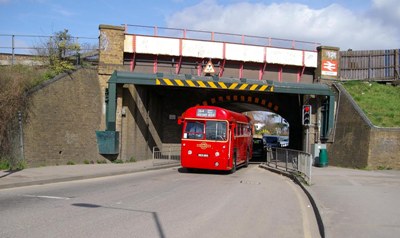 Memories MemoriesStan Attewell started work driving the 264 when it was
crew-operated. Read his memories here.
Re-creation
The 264 was RF-operated at our Kingston RF Event 2009.
Crew-operated RF395 passes
under the bridge at Hersham Station in March 2009.
Photo ©
Dave Simmons
|
|